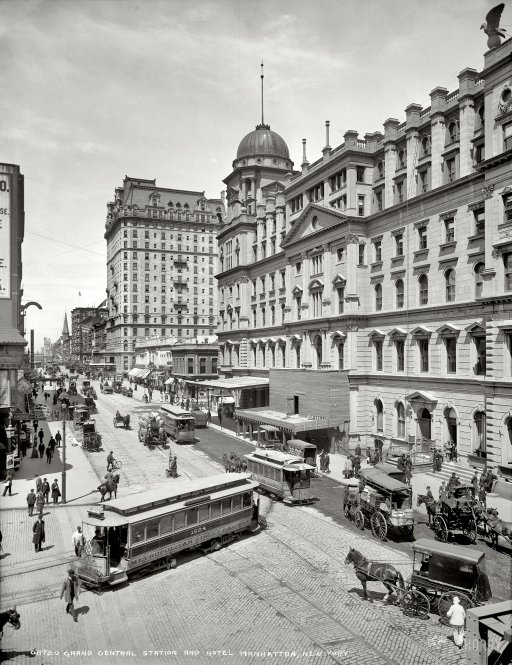
DPC Grand Central Station and Hotel Manhattan, NY 1903



Right. Stability is the goal.
• Nikkei Ends Up After Roller-Coaster Ride On BOJ’s Rate Cut (CNBC)
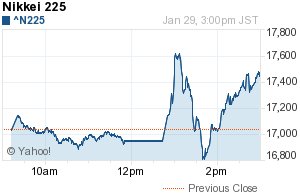
Asian markets climbed, with most indexes trading up, after Japan shares took a roller-coaster ride in the immediate aftermath of the Bank of Japan’s decision to adopt a negative interest rate policy. The Nikkei 225, which traded down 0.6% before the announcement, surged as much as 3.51% soon after, before tumbling as much as 1%. It then surged to close up 2.80%, or 476.85 points, at 17,518.30. After the BOJ move, the yield on the benchmark 10-year Japan government bond (JGB) fell to a record low of 0.11% from around 0.22% before the decision. There was no quick agreement on why the market outlook on the move shifted so quickly.
Gavin Parry at Parry International Trading, suggesting that a move to negative deposit rates just after a supplementary increase in Japan’s qualitative and quantitative easing (QQE) program could have been read to mean the BOJ was running out of bullets. In its statement on Friday, the central bank said it would continue with the QQE and negative interest rate policies for “as long as it is necessary for maintaining that target in a stable manner.” Marcel Thieliant at Capital Economics thought the overall complexity of the BOJ’s move may have spurred the midday selloff. “What they did announce today will be effective. It will lead to lower rates in the money market. But some people had second thoughts once they read the statement,” he said.
He noted that the BOJ had imposed a “three-tier” system on negative rates. With the huge amount of bank reserves currently sitting with the central bank, “if they impose a negative rate on all these balances, it would have a big impact on banks’ profitability,” he said, noting that existing reserves were going to be exempted, but there was likely confusion about how the amounts subject to negative rates would be increased. The dollar-yen pair gained as much as 1.52% in the aftermath of the BOJ announcement, trading as high as 121.35, from around 118.50 before the news. The pair trimmed gains to trade around 120.82 after the Japan stock market closed.

Recovery.
• US Durable Goods Orders Tumbled 5.1% in December (WSJ)
A key measure of U.S. manufacturers’ health suffered its largest annual decline since the recession ended more than six years ago, showing how global headwinds are eroding a onetime pillar of the economy. Demand for long-lasting manufactured products made in the U.S. fell 5.1% in December from a month earlier, and declined 3.5% for all of 2015, the Commerce Department said Thursday. The annual decline in durable-goods orders is the largest outside a recession on records back to 1992. The figures add to mounting evidence the manufacturing sector is contracting. And with the dollar strengthening further this month and financial-market tumult likely threatening business confidence, a factory slowdown could last well into this year. “The entire year of 2015 was pretty much a bust for durable-goods makers,” said Michael Montgomery at IHS Global Insight.
“Industries faced stiff competition from foreign rivals for U.S. market share, and exporters faced intense pressures abroad.” Thursday’s release is in line with data from Institute for Supply Management, a group of purchasing managers, showing a nearly three-year-long expansion in manufacturing came to an end in November. And the Federal Reserve’s reading on industrial production has declined in 10 of the past 12 months, putting it off nearly 2% from its peak in December 2014. A number of forces hampered U.S. factories last year. An economic slowdown in China, Brazil and other markets for U.S. goods limited foreign demand. Meanwhile, a stronger dollar made U.S. goods more expensive overseas and foreign products relatively more affordable for American consumers. And a pullback in U.S. oil production last year reversed a recent source of strength for many metal and equipment makers.

Plenty bubbles created by cheap money are still around.
• Amazon Shares Plunge 13% As Profit Misses Estimates (Reuters)
Amazon.com posted its most profitable quarter ever on Thursday but the world’s No. 1 online retailer still managed to disappoint Wall Street by badly missing estimates, sending its shares down more than 13% in after-hours trading. The results, as well as the company’s determination to invest more in new areas and its extremely low profit margins, brought back perennial questions for investors about the company’s ability to consistently earn money. “By comparative retail standards, Amazon’s level of profitability is still painfully weak,” said Neil Saunders, head of retail analyst firm Conlumino, who is still positive on Amazon’s prospects. “For every dollar the company takes, it makes just 0.75 of a cent in profit.”
Amazon’s net profit for the fourth quarter, which includes the holiday shopping season, rose to $482 million, or $1.00 per share, in the quarter ended Dec. 31, up from $214 million, or 45 cents per share, a year earlier. That figure was held back by rising operating costs. It was well below analysts’ average forecast of $1.56 per share, according to Thomson Reuters. The company’s shares plunged 13% to $551.50 after hours on Thursday, following a 9% increase in regular trading. They are still up 80% over the past 12 months. Amazon notched its third consecutive profitable quarter for the first time since 2012, but it still left Wall Street wanting more. “The growth story that investors were looking for… clearly Amazon has not been able to live up to the hype,” said Adam Sarhan, chief executive of Sarhan Capital.

But China grows 7%?
• The Shipping News Says the World Economy Is Toast (BBG)
In October 2008, as the repercussions of the financial crisis were starting to ripple through the global economy, I noticed a press release from Swedish truckmaker Volvo saying that its European order book had fallen by more than 99% between the third quarters of 2007 and 2008 – to just 155 from 41,970. That prompted me to study various other real-world activity measures ranging from shipping to air freight, and to conclude that “the news is all bad and getting worse, fast.” The same exercise today, I’m afraid to say, leads me to a similar conclusion about the growth outlook. Here’s a chart showing what’s happening to the volume of goods being shipped in containers from China’s ports, one for the country and one for Shanghai. Both indexes are compiled by the Shanghai Shipping Exchange, and cover shipments to the rest of the world including Europe, the U.S. and Africa; activity is down more than 40% from its peak in mid-2012:
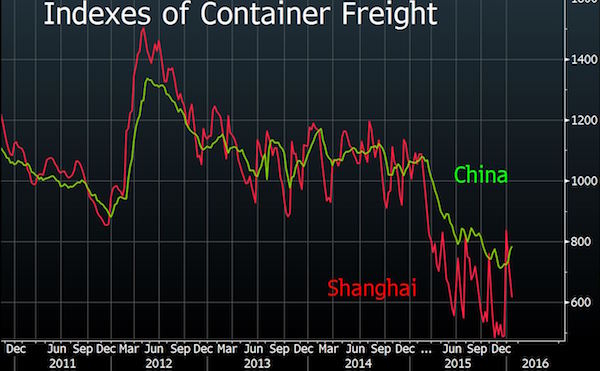
The traditional global shipping measure is called the Baltic Dry Index. Shipping purists (who rival gold bugs in their dedication to minutiae) will tell you it mostly reflects how many vessels are afloat on the world’s oceans; a glut of shipbuilding means more boats available, which drives down the cost of shipping bulk raw materials such as iron ore, steel and coal. But given the fragile state of the global economy, it’s hard to shake the feeling that the index has been trying to tell us something important about global demand in recent years:
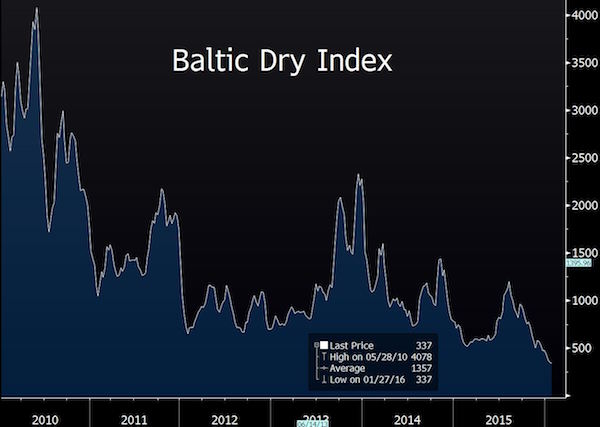

Dave in fine form:..China is the rotten epicenter of the world’s two decade long plunge into an immense central bank fostered monetary fraud..”
• Red Ponzi Ticking (David Stockman)
There is something rotten in the state of Denmark. And we are not talking just about the hapless socialist utopia on the Jutland Peninsula – even if it does strip assets from homeless refugees, charge savers 75 basis points for the deposit privilege and allocate nearly 60% of its GDP to the Welfare State and its untoward ministrations. In fact, the rot is planetary. There is unaccountable, implausible, whacko-world stuff going on everywhere, but the frightful part is that most of it goes unremarked or is viewed as par for the course by the mainstream narrative. The topic at hand is the looming implosion of China’s Red Ponzi; and, more specifically, the preposterous Wall Street/Washington presumption that it’s just another really big economy that overdid the “growth” thing and is now looking to Beijing’s firm hand to effect a smooth transition.
That is, an orderly migration from a manufacturing, export and fixed investment boom-land to a pleasant new regime of shopping, motoring, and mass consumption. Would that it could. But China is not a $10 trillion growth miracle with transition challenges; it is a quasi-totalitarian nation gone mad digging, building, borrowing, spending and speculating in a magnitude that has no historical parallel. So doing, It has fashioned itself into an incendiary volcano of unpayable debt and wasteful, crazy-ass overinvestment in everything. It cannot be slowed, stabilized or transitioned by edicts and new plans from the comrades in Beijing. It is the greatest economic trainwreck in human history barreling toward a bridgeless chasm.
And that proposition makes all the difference in the world. If China goes down hard the global economy cannot avoid a thundering financial and macroeconomic dislocation. And not just because China accounts for 17% of the world’s $80 trillion of GDP or that it has been the planet’s growth engine most of this century. In fact, China is the rotten epicenter of the world’s two decade long plunge into an immense central bank fostered monetary fraud and credit explosion that has deformed and destabilized the very warp and woof of the global economy. But in China the financial madness has gone to a unfathomable extreme because in the early 1990s a desperate oligarchy of despots who ruled with machine guns discovered a better means to stay in power. That is, the printing press in the basement of the PBOC – and just in the nick of time (for them).

What did I say about that devaluation bomb?
• China’s Debt-To-GDP Rises To A Gargantuan 346% (ZH)
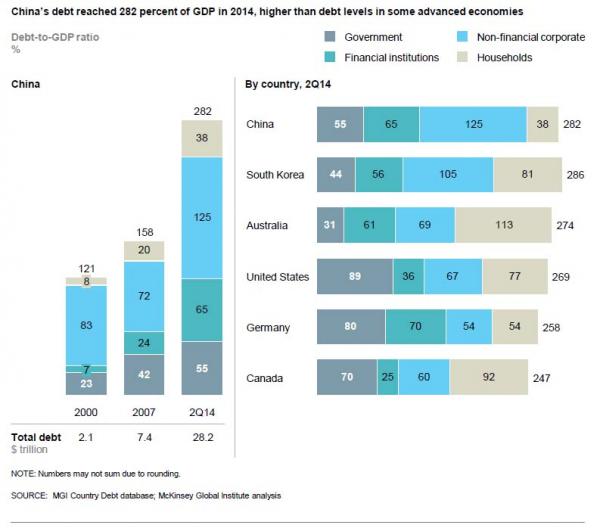
In early 2015, after years of China’s massive debt pile being roundly ignored by most so-called experts (despite being profiled here many years prior), McKinsey released a report showing that not only has the world not delevered since the financial crisis, adding well over $60 trillion in debt (through 2016), but also revealing in a format so simple even an economist could grasp it, just how massive China’s all-in leverage has become. Many were shocked when they read that China’s total debt/GDP had risen by 125% in under 7 years, hitting 282% as of Q2 2014. Those same people may be just as shocked to learn that according to the head of financial markets research Asia Pacific at Rabobank, Michael Every, not only has China not begun to delever at all, but since McKinsey’s update, its debt has risen by another 70% of GDP!
According to Every, China’s 2015 debt-to-GDP might be as high as 346%, and while that is in line with wealthier developed economies but is “vastly higher” than any EM peer. Cited by Bloomberg, Every adds that the time-frame for debt accumulation pre-crisis varies, but what always follows is a major currency drop afterwards, as has happened even with reserve currencies such as dollar, yen, euro and pound. He also adds that nominal GDP needs to rise faster than debt for a sustained period if deleveraging is to truly be under way, aka Dalio’s beautiful deleveraging thesis. The problem, however, is that with even Goldman admitting that China’s real GDP growth rate is about 4.5%, China’s debt load is rising orders of magnitude faster than its underlying economy and is on the daily verge of entering the final phase of the Minsky Moment breakdown.
While no surprise to people with common sense, Every concludes that debt must be repaid with interest, which acts as a drag on economic activity, and is the reason why such monstrous debt loads always lead to an economic collapse; making matters worse is that in China cheap credit is channeled to state-owned firms with low or no profitability. So what happens next? Every believes that China has no choice but to proceed with a massive devaluation, far bigger than the prevailing consensus, and expects the Yuan to plunge to 7.60 against the dollar over the next year.

But wait: if we make interest rates negative, we can make money on being in debt, right?
• The $29 Trillion Corporate Debt Hangover That Could Spark a Recession (BBG)
There’s been endless speculation in recent weeks about whether the U.S., and the whole world for that matter, are about to sink into recession. Underpinning much of the angst is an unprecedented $29 trillion corporate bond binge that has left many companies more indebted than ever. Whether this debt overhang proves to be a catalyst for recession or not, one thing is clear in talking to credit-market observers: It’s a problem that won’t go away any time soon. Strains are emerging in just about every corner of the global credit market. Credit-rating downgrades account for the biggest chunk of ratings actions since 2009; corporate leverage is at a 12-year high; and perhaps most worrisome, growing numbers of companies – one third globally – are failing to generate high enough returns on investments to cover their cost of funding.
Pooled together into a single snapshot, the data points show how the seven-year-old global growth model based on cheap credit from central banks is running out of steam. “We’ve never been in a cycle quite like this,” said Bonnie Baha, a money manager at DoubleLine Capital in Los Angeles, which oversees more than $80 billion. “It’s setting up for an unhappy turn.” While not as pronounced as the rout in global equity markets, losses are beginning to pile up in the bond market too. The average spread over benchmark government yields for highly rated debt has widened to 1.84 percentage points, the most in three years, from 1.18 percentage points in March, according to Bank of America Merrill Lynch indexes.
Investors lost 0.2% on global corporate bonds in 2015, snapping a string of annual gains that averaged 7.9% over the previous six years, the data show. Debt at global companies rated by Standard & Poor’s reached three times earnings before interest, tax, depreciation and amortization in 2015, the highest in data going back to 2003 and up from 2.8 times last year, according to the ratings company. Total debt at listed companies in China, the world’s second-largest economy, has climbed to the highest level in three years, according to data compiled by Bloomberg. Worsening debt profiles contributed to S&P downgrading 863 corporate issuers last year, the most since 2009. More than a third of commodity and energy companies have ratings with negative outlooks or are on credit watch with negative implications, S&P said.

“The problem, however, is that China’s competitors are employing the same tactics and their currencies have more or less shadowed the yuan’s movements against the dollar..”
• Capital Flight Is The Evil Twin Brother Of Currency War (MW)
A currency war is not all it’s cracked up to be. That is the verdict from Citi’s currency expert Steven Englander, who argues that efforts by central banks to devalue their currencies to maintain an edge over competing economies are not as effective as many are led to believe. “Policy makers and investors talk about currency depreciation as if it is the ultimate weapon of economic policy, but that overstates its importance in driving activity,” said Englander in a report. “The economic bang for the depreciating buck, or yen or euro is relatively small.” The currency strategist stressed that engaging in a currency war is mostly an exercise in futility, in part because it is not all that effective as a monetary tool. “You have to go much further than you think for much longer than you think,” he said.
And if a country has to rely on manipulating the exchange rate to prop up the economy, then it may be in worse trouble than those in charge want to admit, according to Englander. While the criticism was not specifically directed at China, the observation coincides with a continuing debate over how far Beijing will go to weaken its currency in a bid to prop up its flagging economy. Economists generally expect the Chinese government to depreciate the renminbi to bolster export competitiveness to combat a sharp economic slowdown. The People’s Bank of China officially projected GDP to grow 6.8% in 2016 versus 6.9% last year with some economists projecting GDP growth to decelerate to around 6.5%. The problem, however, is that China’s competitors are employing the same tactics and their currencies have more or less shadowed the yuan’s movements against the dollar, according to Englander.
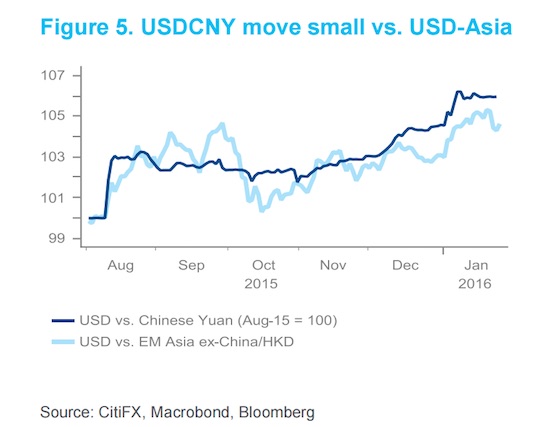
“If the trading partners keep matching CNY depreciation at this pace, CNY will have to go a long way before any material competitive advantage emerges,” he said. That has not deterred the Chinese authorities from pushing the currency lower after its dramatic devaluation in August and analysts project the yuan-dollar pair to soften to 7 by the end of the year from 6.57 currently. Ironically, in a bid to buttress the economy via the cheap yuan, China faces the risk of accelerating capital outflows. “Capital flight is the evil twin brother of currency war,” Englander said. “If currency war is typically capital outflows encouraged by government policy, capital flight is currency war driven by the private sector with policy makers typically on the other side.”
The Institute of International Finance last week estimated that $676 billion exited China in 2015 and outflows are likely to continue this year, further exposing the yuan to speculative attacks.

“..the $700 billion decline in China’s foreign-currency reserves is bigger than the total foreign-currency reserves of all but three other central banks in the world—Japan, Switzerland and Saudi Arabia..”
• Hundreds of Billions of Dollars Have Fled China. Now What? (WSJ)
For lovers of dramatic numbers, China has long been a gift. The flood of cash leaving the country has produced another impressive statistic: We are witnessing the greatest episode of capital flight in history. China’s foreign-exchange reserves fell by $700 billion last year. The flood of cash across its borders is complicating the country’s economic transformation and is raising the risks of problems in other emerging markets, where cash already is flowing outward. “What happened in 2015 coming out of China was unprecedented in magnitude,” said Charles Collyns, chief economist for the Institute of International Finance, a global trade group for the financial industry. The size of China’s $10 trillion economy and its still-huge foreign reserves means the outflow won’t cause an immediate crisis in the country, though there are risks.
According to World Bank data, the $700 billion decline in China’s foreign-currency reserves is bigger than the total foreign-currency reserves of all but three other central banks in the world—Japan, Switzerland and Saudi Arabia. China’s outflows are the biggest in absolute terms, although other countries have had larger outflows relative to the size of their economies. The big worry is that China devalues its currency, which would come at a time that money already is flowing out of emerging markets as investors grow more risk averse and the U.S. Federal Reserve slowly begins to raise interest rates. If the yuan does fall further, it makes the economies of its Asian neighbors less competitive. That could lead to more capital flight from emerging markets, which could drain foreign-currency reserves in countries trying to keep their currencies from falling.
Places that do see their currencies tumble also could face inflation, slowing investment and tapering growth. Most historical cases of capital flight have one main cause—economic turmoil, political instability or an outside crisis that leads investors to pull their cash home. In China, however, there are several interconnected reasons that both locals and foreigners are pulling out their money, and the combination appears to be making the situation worse.
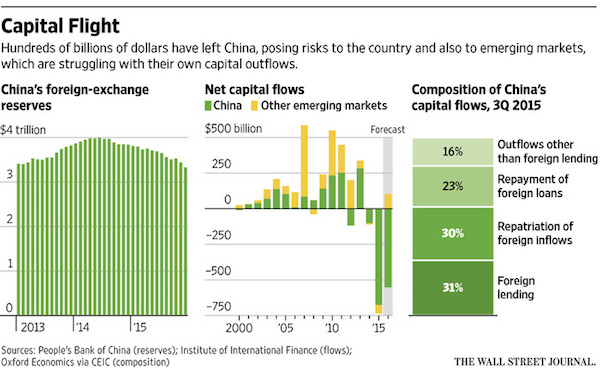

“..nearly $1.6 trillion in Quantiative Tightening is taking place just due to China’s attempts to stem capital flight..”
• China’s January Outflows Soar To Second Highest Ever (ZH)
While China’s currency devaluation has, alongside the price of commodities, become one of the two key drivers of market volatility and tubulence around the globe, when it comes to risk, one far more important Chinese metric is the actual amount of capital that leaves the nation. The reason for this is that as explained over the weekend, in a world where Quantitative Tightening by EMs and SWFs has emerged as a powerful counterforce to Quantitative Easing – or liquidity injections – by developed central banks, what matters for global risk levels is the net effect of these two opposing money flows. Of all the global “quantitative tighteners”, the biggest culprit is China, which has seen over $1 trillion in reserve selling since the summer of 2014, the direct result of a virtually identical amount in capital outflows.
Furthermore in for a “closed’ Capital Account system like is China, the selling of FX reserves is a direct function of capital outflows, so the only real data needed to extrapolate not only the matched reserve selling and thus Quantitative Tightening, but also the direct impact onglobal risk assets, is how much capital outflow has taken place. This takes place in one of two ways: by relying on official Chinese historical data, or by estimating how much outflows take place on a concurrent basis, thus allowing one to estimate how much capital is flowing out in real time. Indicatively, China’s SAFE released onshore FX settlement data for the whole banking system (PBoC+banks), suggesting some $97bn of FX outflows in Dec, which is broadly in line with the fall in official reserves.
But much more important is the question what is taking place right now, the answer to which can either wait until SAFE releases January data in several weeks… or rely on day to day estimates of outflows in the form of central bank FX intervention. Luckily, we have just that. According to a Goldman report, so far in January “there has been around $USD 185bn of intervention (with the recent intervention predominantly taking place in the onshore market)” split roughly $143 billion on the domestic side and $42 billion on the offshore Yuan side. This would make January the month with the second largest amount of intervention since August 2015, and thus the second highest month of capital outflows, and would explain the ongoing deterioration across global asset classes as China’s various FX reserve managers have been forced to sell not just government bonds but equities as well.
Goldman also calculates that “total intervention over the last 6 months, using our estimates, sums to USD 775bn.” Run-rating this amount would suggest that nearly $1.6 trillion in Quantiative Tightening is taking place just due to China’s attempts to stem capital flight. This number excludes the hundreds of billions in reserves that all other petrodollar and EM nations have to liquidate as well to prevent the rapid devaluation of their own currencies as the world remains caught in the global dollar margin call we first explained in early 2015.
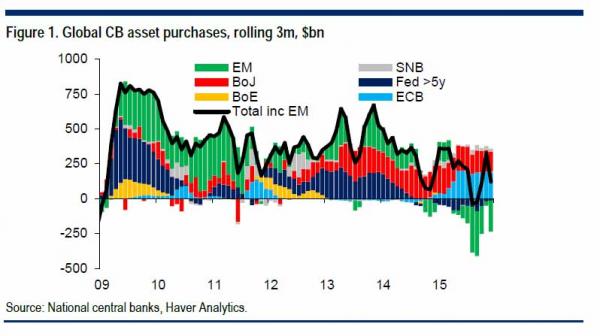

Even CNN gets alarmed. Graph is not from article, but seems a good fit.
• Cracks In America’s Economy Are Growing (CNN)
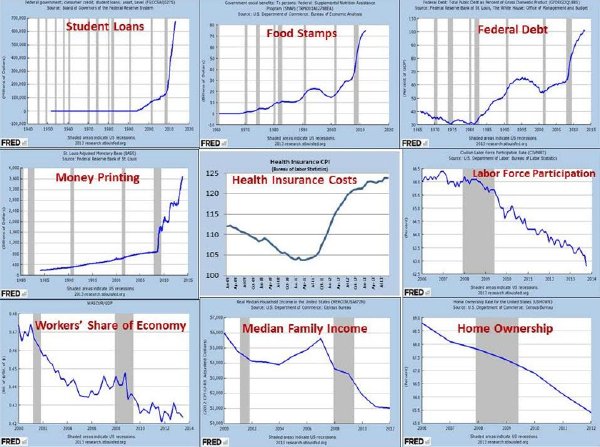
America’s economy hit the brakes during the holidays. Some recent economic data even raises fears that we might be heading towards a possible U.S. recession in 2016. Big banks like Morgan Stanley estimate there’s a 20% chance of recession this year. On Friday, the government will release data that show how the U.S. economy fared in the last three months of the year. Many experts forecast that the U.S. economy barely grew – about 1% or less – between October and December of 2015 compared to a year ago. Even the Federal Reserve admitted Wednesday that the economy “slowed” at the end of last year. On Thursday, the bad news continued. A key sign of confidence is orders for new products and equipment – known as “durable goods” – placed by companies to power their business.
Orders for durable goods fell 5% between November and December, according to the Commerce Department. That was a lot below expectations that orders would be flat. It shows that some companies are delaying or deciding not to purchase any new piece of equipment they need. The news on durable goods caused Barclays (BCS) to lower its GDP forecast to 0.4% on Thursday. Capital Economics, a research firm, admitted the new data posed risks “firmly to the downside” for its estimate of 1%. Here are 3 more warning signs that the U.S. economy is heading in the wrong direction:
1. American are not spending much U.S. economic growth depends on shoppers. Consumer spending makes up two-thirds of the nation’s economic engine. Yet they’re sending mixed signals: U.S. retail sales declined a bit in December and they were negative or flat seven times last year. Consumer confidence has wavered too. It peaked at 98% in January 2015 but has since drifted down in general. Consumer confidence is currently 93%. While it’s a lot better than what it was just a few years ago, any downward movement is still a cause for concern.
2. U.S. manufacturing already in recession American factories are suffering from the global economic slowdown. Manufacturing makes up 10% of the U.S. economy, according to Morgan Stanley. The key ISM manufacturing index has declined for six straight months, and its been negative – below 50% – for the last two months. The strong dollar is making products manufactured in the U.S. more expensive overseas, lowering demand for American made goods. The slowdown in emerging market economies isn’t helping trade either.
3. Corporate America is hurting Earnings season isn’t over yet but one thing is clear: American companies are making less money than a year ago. Put together, when America’s biggest companies – and employers – suffer, the economy follows suit. The S&P 500 is down 7% so far in January. Apple, the nation’s biggest company by market size, just announced record profits with a gloomy outlook ahead. It believes iPhone sales will decline in the first quarter of this year for the first time in 13 years. Apple CEO Tim Cook expressed serious caution about the global economy. When a major American CEO raises the warning flag that’s not good for the U.S. economy. “We’re seeing extreme conditions unlike anything we have experienced before just about everywhere we look,” Cook said Tuesday.

Waiting for the final whistle..
• How Italy’s Bad Loans Built Up (FT)
The EU agreed a deal with Italy on Wednesday to help Italian banks sell off their large portfolios of non-performing loans to private investors, in the hope it will restore confidence in the country’s troubled banking system. The move came as concerns over the loans — worth 21% of GDP— sent Italian banks’ share prices into freefall, heaping pressure on the sector. A logjam of bad loans has built up over the past decade as economic stagnation, multiple recessions and a weak recovery have weighed on companies, particularly smaller businesses that account for the majority of Italy’s business make-up. According to the Italian Association of Banks, the ratio of bad loans is higher for loans to small companies than the large ones. These charts show how Italy grew as a lender of bad loans, and the banks that have been most affected.
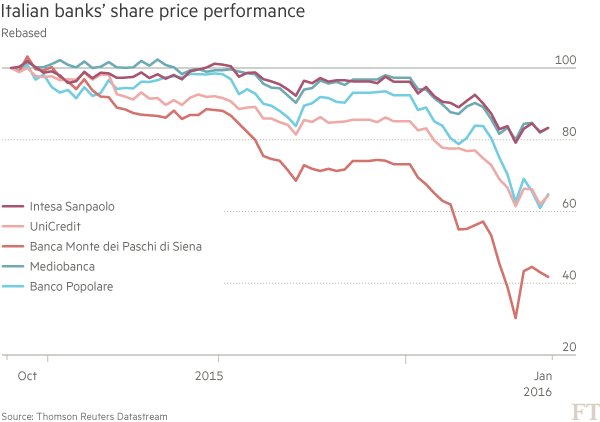
Since the onset of the financial crisis, Italian banks have accrued a much larger exposure to non-performing loans than other large European countries. The EU average for non-performing loans as a percentage of total loans is 6%; in Italy the proportion has reached 17%. Slow growth has been a big setback. In the fourth quarter last year, Italian GDP was at the same level as at the beginning of 2000, while that of Germany and France grew 20%. Italy returned to growth at the start of 2015, but the recovery has been anaemic with quarterly growth rates below 0.5%. Until economic growth picks up strongly, any decline in the relative proportion of non-performing loans held by Italy’s banks is likely be marginal, as it was in 2015.
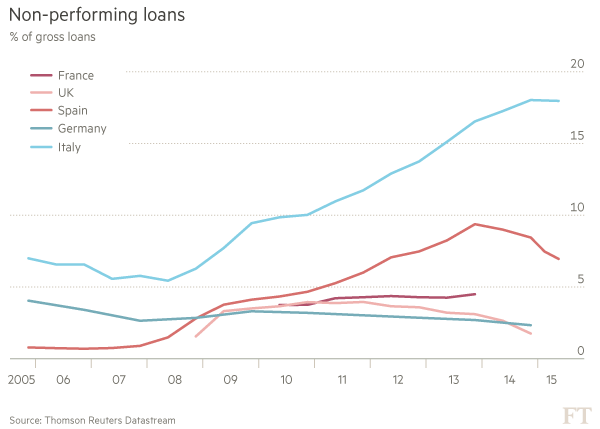

I’m all for it.
• Brexit Vote To Turn UK Into ‘Safe Haven’ Triggering EU Disintegration (Tel.)
A British exit from the European Union could see the UK becoming a “safe haven” amid a disintegrating Europe, Barclays has said. Analysis from the bank said a ‘leave’ vote would open a “Pandora’s Box” in the crisis-hit continent, and could dissuade Scotland from breaking away from the relative safety of the UK. Barclays said financial markets had failed to grasp the sheer “breadth” of the British vote, calling it one of “the most significant global risks of the year”, and one which could lead to the collapse of the European project. Investors have been selling off the pound in anticipation of an EU referendum, which could take place as early as the summer. Sterling has depreciated by 9pc against the single currency since November.
But if Britain voted for an EU exit, the political and institutional reverberations on the continent would be far greater than any economic fall-out, said the bank, who compared the implications to that of a “Grexit”. A number of European countries would be caught in the grip of extremist left-wing and right-wing populist parties, pushing them towards leaving the EU, they said. “If politics in the EU turned for the worse, the UK may be seen as a safe haven from those risks, reversing the euro’s exchange rate appreciation”, said the report’s authors. “In that environment, Scottish voters could be even less inclined to leave the relative safety of the UK for an increasingly uncertain EU”. The warning echoes fears that Europe, rather than the UK, would suffer the worst consequences of a Brexit.
Deutsche Bank’s chief economist said earlier this week that Brexit would be “devastating” for the continent, consigning Europe to the status of a “second rank” power. “The referendum is generally seen as a ‘UK’ issue, when it is better seen as a European issue” said Philippe Gudin of Barclays. Analysts highlighted the “emotionally charged” immigration debate as a “wildcard” which could see the UK leave the EU. Survey data shows concerns about immigration have surged to become the most important issue facing the EU, according to voters – elicpsing fears over economy, terrorism, and unemployment since the start of 2015. Should Brexit occur, this would embolden other member states who are struggling to control immigration and unleash a fresh wave of turmoil in the EU, said Barclays.

Give them something to go back to.
• Germany Tightens Refugee Policy, Finland Joins Sweden In Deportations (Guar.)
Germany has moved to toughen its asylum policies as Finland and Sweden announced plans to deport tens of thousands of people in a bid to contain the migrant crisis. Sigmar Gabriel, the vice chancellor, announced that Germany would place Algeria, Morocco and Tunisia on a list of “safe countries of origin” – meaning that migrants from those countries would have little chance of winning asylum. Some migrants would also be blocked from bringing their families to join them in Germany for two years, Gabriel said. The tougher rules come after Germany, the European Union’s powerhouse economy, took in some 1.1 million migrants in 2015 – many of them refugees fleeing conflict in Syria.
German chancellor Angela Merkel has come under fierce pressure in recent months to reverse her open-arms policy to those fleeing war and persecution, including opposition from within her own conservative camp. Finland meanwhile joined Sweden on Thursday in announcing plans to deport tens of thousands of refused asylum seekers. The two Nordic countries are both struggling to cope with an influx of refugees and migrants fleeing misery in the Middle East and elsewhere – receiving amongst the highest numbers of arrivals per capita in the EU. The Finnish government expects to deport around two thirds of the 32,000 asylum seekers that arrived in 2015, Paivi Nerg, administrative director of the interior ministry, told AFP.
“In principle we speak of about two-thirds, meaning approximately 65% of the 32,000 will get a negative decision (on their asylum applications),” she told AFP. In neighbouring Sweden, interior minister Anders Ygeman said on Wednesday that the government was planning over several years to deport up to 80,000 people whose asylum applications are set to be rejected. “We are talking about 60,000 people but the number could climb to 80,000,” he told Swedish media, adding that, as in Finland, the operation would require the use of specially chartered aircraft. He estimated that Sweden would reject around half of the 163,000 asylum requests received in 2015.
Swedish migration minister Morgan Johansson said authorities faced a difficult task in deporting such large numbers, but insisted failed asylum seekers had to return home. “Otherwise we would basically have free immigration and we can’t manage that,” he told news agency TT. The clampdown came as at least 31 more people died trying to reach the EU. Greek rescuers found 25 bodies, including those of 10 children, off the Aegean island of Samos, in the latest tragedy to strike migrants risking the dangerous Mediterranean crossing hoping to start new lives in Europe. The Italian navy meanwhile said it had recovered six bodies from a sinking dinghy off Libya – and in Bulgaria, the frozen bodies of two men, believed to be migrants, were found near the border with Serbia.

This will fail.
• Mass Expulsions Ahead For Europe As Refugee Crisis Grows (AP)
Dazzled by an unprecedented wave of migration, Sweden on Thursday put into words an uncomfortable reality for Europe: If the continent isn’t going to welcome more than 1 million people a year, it will have to deport large numbers of them to countries plagued by social unrest and abject poverty. Interior Minister Anders Ygeman said Sweden could send back 60,000-80,000 asylum seekers in the coming years. Even in a country with a long history of immigration, that would be a scale of expulsions unseen before. “The first step is to ensure voluntary returns,” Ygeman told Swedish newspaper Dagens Industri. “But if we don’t succeed, we need to have returns by coercion.” The coercive part is where it gets uncomfortable.
Packing unwilling migrants, even entire families, onto chartered airplanes bound for the Balkans, the Middle East or Africa evokes images that clash with Europe’s humanitarian ideals. But the sharp rise of people seeking asylum in Europe last year almost certainly will also lead to much higher numbers of rejections and deportations. EU officials have urged member countries to quickly send back those who don’t qualify for asylum so that Europe’s welcome can be focused on those who do, such as people fleeing the war in Syria. “People who do not have a right to stay in the EU need to be returned home,” said Natasha Bertaud, a spokeswoman for the EU’s executive Commission.
“This is a matter of credibility that we do return these people, because you don’t want to give the impression of course that Europe is an open door,” she said. EU statistics show most of those rejected come from the Balkans including Albania and Kosovo, some of Europe’s poorest countries. Many applicants running away from poverty in West Africa, Pakistan and Bangladesh also are turned away. Even people from unstable countries like Iraq, Afghanistan and Somalia can’t count on getting asylum unless they can prove they, personally, face grave risks at home.

Just numbers. That’s all you need to know.
• Why Europe’s Refugee Crisis May Be Getting Worse (BBG)
More than 50,000 refugees fleeing violence and unrest in the Middle East and Africa have arrived on Europe’s shores already this month — almost 10 times as many as in January 2015. This unrelenting influx will add to the pressure on leaders who are already reeling from the impact of the crisis. With European Union countries reintroducing border controls, chaos at Europe’s external frontiers and the threat of terrorism associated with the civil war in Syria looming over the continent’s largest cities, the dilemma has fractured European politics and frayed the social fabric. The following charts show why the worst may yet be to come.
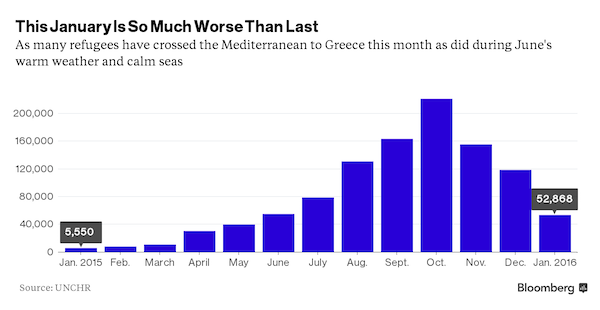
The number of refugees fleeing to Greece by sea this month is almost 10 times what it was this time last year, according to UNHCR data through Jan. 27. Normally the winter months are quieter as migrants wait for better weather but with this January’s total almost as high as that of last June, the figures suggest that Europe will continue to face a huge inflow. As the crisis in Syria has intensified, the makeup of the refugees has changed. Whereas in 2015 more than half of the migrants arriving in Greece were men, that’s now slipped to 44% as whole families follow them to seek asylum in Europe.
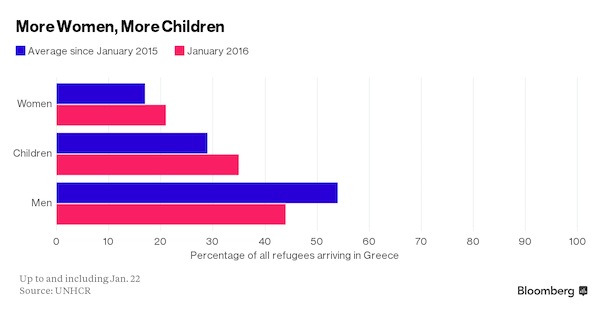

And we keep on going.
• Twelve Refugees Drown As Boat Sinks Off Greek Island (Reuters)
Twelve migrants drowned when their boat sank off a Greek island close to Turkey, the Greek coastguard said on Thursday, as people continue to make crossings to Europe despite the harsh winter conditions. “A man who managed to swim to the shore told Greek authorities the boat carried 40 to 45 people,” a coastguard official said. The sinking occurred late on Wednesday north of the island of Samos in the eastern Aegean Sea, close to the Turkish coast. Nine people have been rescued so far, and Frontex and coastguard vessels are looking for other survivors. “We are not sure if the nine rescued were among the 45 or if they were on a different boat,” the official said.

On average, 8 people have reportedly drowned every single day this year.
• 24 Iraqi Kurdish Refugees Drown Off Greek Island (NY Times)
At least 24 people drowned and 11 others were missing after a boat carrying Iraqi Kurds sank off the Greek island of Samos in the Aegean Sea, close to Turkish coast, the authorities said on Thursday. More than 3,700 migrants died while trying to enter Europe via the Mediterranean last year, and the latest sinking was a reminder that the flow has not stopped in the dead of winter. Kelly Namia, an Athens-based representative of the International Organization for Migration, confirmed the death toll. According to accounts provided to the organization at a hospital, the wooden vessel was carrying 65 people, when it sank on Wednesday night, even though it had a maximum capacity of 30 people. The passengers were all Iraqi Kurds, aside from the smugglers, who were believed to be Afghans. At least one smuggler is believed to have drowned, but his body has not been located, Ms. Namia said. The Greek Coast Guard continued to search for survivors Thursday afternoon, using vessels and a helicopter.

Number of refugees fleeing to Italy rises sharply again.
• Italy Navy Recovers Six Bodies, Rescues 209 From Migrant Boats (Reuters)
Italy’s navy rescued 290 migrants and recovered six bodies from the water near a half-sunken rubber boat on Thursday, the first sea deaths recorded on the North Africa to Italy route this year, a spokesman said. The navy rescued 109 migrants from a large rubber boat in the morning, and then 107 from a second boat a few hours later. When the navy arrived at a third rubber craft, it was sinking. They managed to pull 74 to safety, but six bodies were recovered from the water. A navy helicopter is continuing to search for survivors, the spokesman said.
Italy and Greece are on the frontline of Europe’s biggest immigration crisis since World War Two, with overcrowded boats packed with migrants reaching their shores from North Africa and Turkey by the hundreds. The sea route to Italy from Africa is the most dangerous border for migrants in the world. Of the more than 3,700 migrant deaths in the Mediterranean in 2015, about 2,000 perished on the way to Italy from North Africa. After a lull in arrivals during the first three weeks of this year, Libya-based people smugglers have taken advantage of recent mild weather to send out boats. Italy’s coastguard said 1,271 migrants were rescued on Tuesday.








